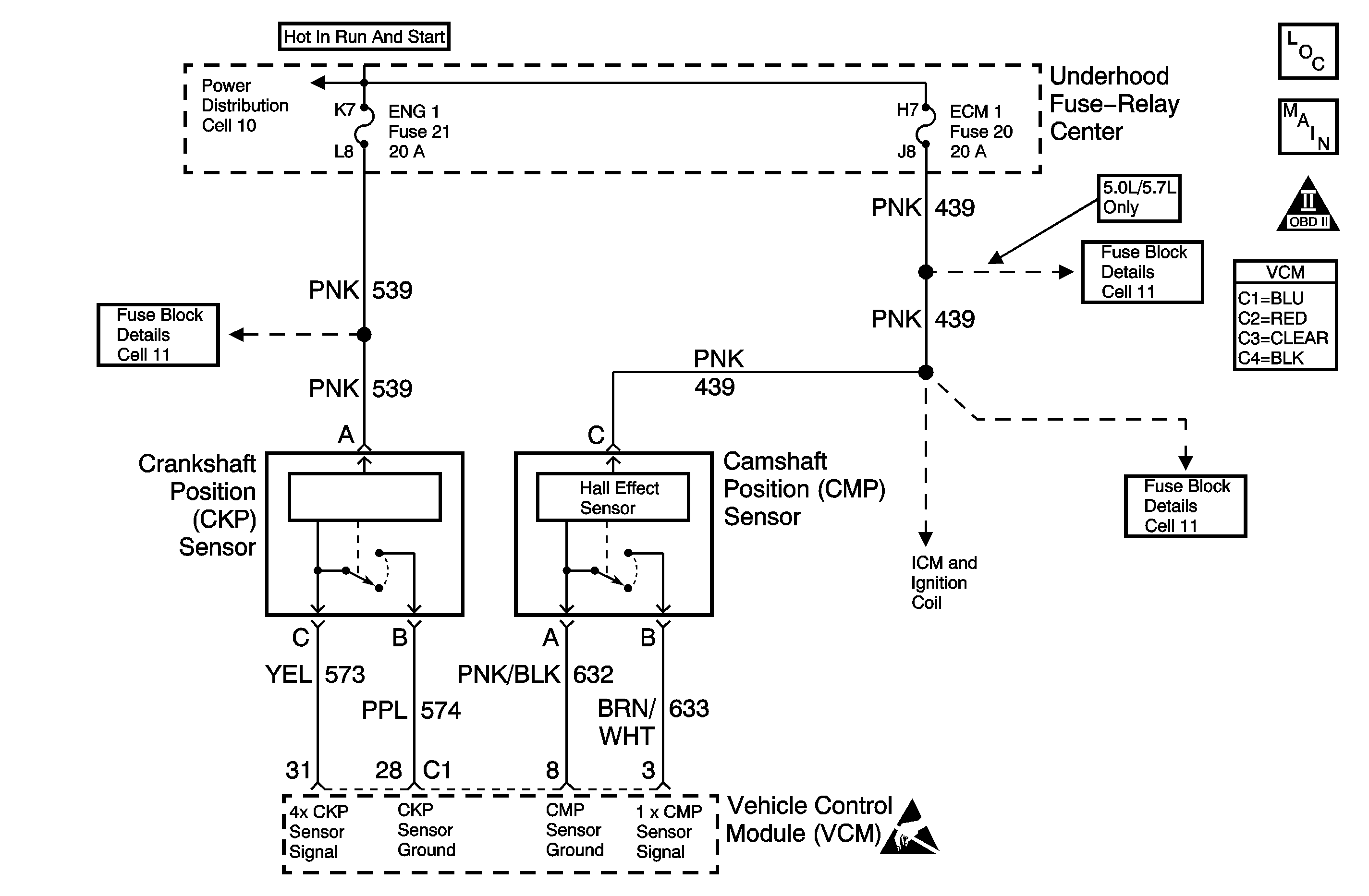
Circuit Description
The Crankshaft Position (CKP) sensor sends a reference signal to the Vehicle Control Module (VCM) in order to indicate the crankshaft position and the RPM so that the VCM can determine when to pulse the ignition coil, the fuel injectors, and the control ignition timing. This is a type D DTC.
Conditions for Setting the DTC
The following conditions will set the DTC:
| • | The engine speed is less than 4000 RPM |
| • | The MAF sensor is at least 5 g/s |
Action Taken When the DTC Sets
The VCM stores the DTC in History if the VCM detects an intermittent problem.
Conditions for Clearing the MIL/DTC
The VCM turns OFF the MIL after 3 consecutive driving trips without a fault condition present. A history DTC will clear if no fault conditions have been detected for 40 warm-up cycles (the coolant temperature has risen 22°C (40°F) from the start-up coolant temperature and the engine coolant temperature exceeds 71°C (160°F) during that same ignition cycle) or the scan tool clearing feature has been used.
Diagnostic Aids
A poor connection, a rubbed through wire insulation, or a wire that is broken inside the insulation may cause an intermittent problem.
Thoroughly check any circuitry, that is suspected of causing the intermittent complaint for the following conditions:
| • | Backed out terminals |
| • | Improper mating |
| • | Broken locks |
| • | Improperly formed or damaged terminals |
| • | Poor terminal to wiring connections |
| • | Physical damage to the wiring harness |
Inspect the face of the CKP sensor for metal shavings. This could result in an intermittent DTC P0339.
Refer to Intermittent Conditions .
Test Description
The numbers below refer to the step numbers on the diagnostic table.
-
This step determines if DTC P0337 is the result of a hard failure or an intermittent condition.
-
Determines if voltage is available to the CKP through the VCM.
-
If the feed circuit is shorted to ground, the test lamp will light. This step determines if the circuit is open or shorted to ground. If the circuit is OK, then the VCM connections or VCM is faulty.
-
This test checks the crank sensor, the crank sensor signal circuit and the VCM.
Step | Action | Value(s) | Yes | No |
|---|---|---|---|---|
1 |
Important: Before clearing DTCs use the scan tool to record the freeze frame and failure records for reference, as data will be lost when Clear Info function is used. Was the Powertrain On-Board Diagnostic (OBD) System Check performed? | -- | ||
Is the lamp on? | -- | |||
Is the lamp on? | -- | |||
Is the test lamp on? | -- | |||
Is the duty cycle less than the specified value? | 30% | |||
6 | Check for a faulty connection at the CKP sensor. Was a problem found? | -- | ||
7 | Check for an open in the CKP sensor low circuit. Was a problem found? | -- | ||
8 | Check for an open or a short to a ground in the CKP sensor feed circuit. Was a problem found? | -- | -- | |
9 | Check for a faulty connection at the VCM. Was a problem found | -- | ||
10 | Repair short to ground in Crankshaft Position sensor 4X signal circuit. Refer to Wiring Repairs in Engine Electrical. Is the repair complete? | -- | -- | |
11 | Replace the CKP sensor. Refer to Crankshaft Position Sensor Replacement . Is the action complete? | -- | -- | |
12 | Repair the circuit as necessary. Refer to Wiring Repairs in Engine Electrical. Is the action complete? | -- | -- | |
13 | Replace the VCM. Important: If the VCM is Faulty, program the new VCM. Refer to VCM Replacement/Programming .Is the replacement complete? | -- | -- | |
14 |
Does scan tool indicate that this diagnostic ran and passed? | -- | ||
15 | Using the scan tool, select Capture Info and Review Info. Are any DTCs displayed that have not been diagnosed? | -- | Go to The Applicable DTC Table | System OK |
